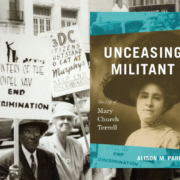— ALISON PARKER, HUMANITIES NEW YORK
Expressing an early version of the theory of intersectionality at the turn-of-the-twentieth century, Mary Church Terrell identified herself as “a colored woman in a white world” who experienced both racism and sexism. Throughout her life, Terrell also publicly advocated on behalf of black girls and women who were unfairly convicted for defending themselves against assaults by whites. Today, black women activists have similar priorities. Kimberle Crenshaw’s African American Policy Forum, for instance, coined the hashtag movement #SayHerName, urging the Black Lives Matter movement to bring specific attention to police violence against black women such as Sandra Bland, Tanisha Anderson, and Breonna Taylor. They are also drawing attention to the fact that black women are being incarcerated at increasing and disproportionate rates. Unceasing Militant, my forthcoming biography of Mary Church Terrell, shares the life and priorities of a black feminist foremother whose voice was insistent, clear, and powerful.
An exclusive excerpt from Unceasing Militant.
As she pursued voting rights, Terrell simultaneously engaged in a related effort to achieve equality by dismantling racist and sexist stereotypes about black women as sexually impure. The National Association of Colored Women had formed in 1896 in part to provide black women with a national platform from which to defend themselves against scurrilous slander by hostile whites. Such slander had become an excuse for dismissing concerns about sexual violence against black women.37
Determined to protect her own and all African American daughters from these racially prejudiced and gendered stereotypes as they grew into young womanhood, Terrell wrote and spoke explicitly about sexual purity. Her public speeches offered cogent critiques of racist caricatures that demonized black girls and women as impure, a stereotype that put them at increased risk of harm. White and black audiences and the newspapers reacted strongly to Terrell’s piercing analyses of how sexism and racism affected the lives of all African American girls and women who had to live and survive in a culture that assumed their racial and sexual impurity.
— Credits
Featured Image
FULL ARTICLE @ HUMANITIES NEW YORK
— Related
The National Association of Colored Women’s Clubs (NACWC) is an American organization that was formed in July 1896 at the First Annual Convention of the National Federation of Afro-American Women in Washington, D.C., United States, by a merger of the National Federation of African-American Women, the Woman’s Era Club of Boston, and the Colored Women’s League of Washington, DC, at the call of Josephine St. Pierre Ruffin. From 1896 to 1904 it was known as the National Association of Colored Women (NACW). It adopted the motto “Lifting as we climb”, to demonstrate to “an ignorant and suspicious world that our aims and interests are identical with those of all good aspiring women.” When incorporated in 1904, NACW became known as the National Association of Colored Women’s Clubs (NACWC).[
Source – National Association of Colored Women’s Clubs (Updated: 20 October 2020) Wikipedia. Available at https://en.wikipedia.org/wiki/National_Association_of_Colored_Women%27s_Clubs, (Accessed: 26 October 2020)

